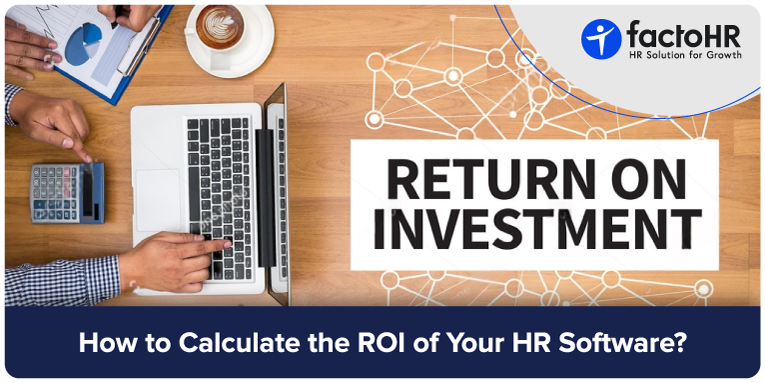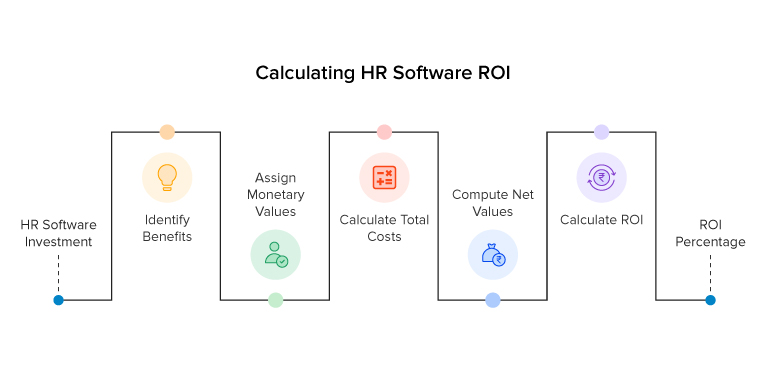How to Calculate ROI of HR Software

Table of Contents
As businesses continue to evolve, HR departments are increasingly relying on technology to manage tasks and support employees more effectively. To enhance accuracy and efficiency, many organizations are relying on HR software to handle their HR tasks, reduce manual errors, and save valuable time. However, as organizations invest in these advanced tools, a pertinent question arises: How do you calculate the return on investment of your HR software?
Well, this is why, in this blog, we will outline the steps you need to take to calculate the return on investment. Additionally, we will also provide you with an idea of how to measure the effectiveness of your Human Resources software product. With this insight, you will be able to understand what ROI is and the best way to calculate the Return on Investment of your HR software.

What is HR Software ROI?
HR Software ROI defines the monetary return that organizations gain from using the software compared to its acquisition costs. This ROI allows firms to determine the extent of benefits the software brings to the company, helping to decide if the investment was worth it or not. For instance, using an Applicant Tracking System will lower recruiting costs, as it shortens the time taken in the process and reduces advertising costs. Additionally, mistakes that could be costly to rectify are minimized when aspects like payroll are automated rather than performed by the HR staff.
This is why determining the return on investment (ROI) of HR software is essential. So, how to measure HR software ROI? To calculate this, organizations can use the following formula:
ROI = (Current Value of the Investment – Total Investment Cost) / Total Investment Cost x 100.
To do this, consider the upfront investment in HR software, along with the potential savings from HR activities such as recruitment, reducing payroll errors, and overall cost savings from increased efficiency. Calculating this helps compare the obtained ROI percentage to organizational expectations, which in turn determines the business’s growth and performance after the software is installed.
Benefits of Investment in HR Software
Making a positive impact on organizational improvement through the acquisition of HR software brings significant value and leads to a better return on investment (ROI). It includes task automation, increased accuracy, and enhanced compliance, which improve HR practices and employee interactions, resulting in a larger return on investment (ROI) for HR systems.
HR software doesn’t just positively impact businesses from a cost-saving perspective but also fosters a healthy culture among organizational members. To understand the full benefits of HR software, explore the detailed insights shared by factoHR, which highlight key advantages and organizational value points.
- Time-Saving: Automates tasks, allowing HR to focus on strategy.
- Fewer Compliance Errors: Organizes data in one place, reducing errors and fines.
- Smarter Decisions: Offers real-time data for better HR decisions.
- Happier Employees: Enhances employee experience and retention.
- Better Hiring: Streamlines recruitment and improves candidate screening with AI.

How to Calculate the ROI of Your HR Software

The HR software measures the return on investment, which is crucial when trying to convince organizational management to approve the costs associated with acquiring it. The basic HR ROI calculation is quite simple and can be expressed as the following:
ROI = (Current Value of Investment – Total Investment Cost) / Total Investment Cost x 100
However, to calculate the appropriate HR tech ROI, one needs to take more time and effort to identify the cost of the benefits provided by the HR software. Here are the steps to follow:
Step 1: Identify the Benefits
Identify the strengths that are likely to be received from the adoption of the software, including efficiency, engagement, lower turnover, and a reduction in repetitive tasks. These outcomes can be considered in terms of both short-run and long-run benefits.
Step 2: Assign Monetary Values
Determine the financial worth of each respected benefit in terms of money over a given period. For instance, determine the actual and estimated cost savings achievable through minimized administrative work or the streamlined financial benefits that reduce turnover rates in the organization.
Step 3: Calculate Total Cost
To list all the total expenses related to the HR software and bind up the necessary costs, such as implementation fees, subscription fees, customization fees, support fees, and training fees. It is crucial to consider the costs that are associated with the current Human Resource system that this new software is going to replace.
Step 4: Compute Net Value
The next step is to total all the costs identified in step 3 and subtract the total expenses from step 3 from the benefits obtained in step 2 to determine the net value of the software investment in HR.
Step 5: Calculate ROI
Determine the investment amount and then use the ROI formula to measure the return on investment. For example, if after 3 years of using the particular type of software, the business derives benefits worth $3,00,000 while the cost of the software was $2,40,000, then the business’s return on investment would be:
ROI = (3,00,000 – 2,40,000) / 2,40,000 * 100 = 25%
Step 6: Monitor Key HR Metrics
On a quarterly or annual basis, monitor key HR indicators to ensure the ROI information for your HR software remains up-to-date and accurate.

5 HR Metrics that Prove Software ROI
It is crucial to demonstrate the various benefits of using HR software to establish a return on investment (ROI) ratio. Good HR software will not only manage data more effectively but also nurture employees, which will prove to be a great advantage to the company’s profit base. To ensure a real return on investment (ROI) from using the software, organizations can track key HR metrics.
Human capital management tools, such as factoHR, help tackle HR metrics and strategically centralize the HR department of the establishment. Here is a list of 5 strategic HR performance indicators that will help you quantify and explain the value of the implemented HR software.
1. Time Savings for HR Employees
Formula: Time Savings = (The time the employee takes to complete the task manually – The time it takes for the program to complete the task) multiplied by the hourly rate paid to the employee.
For Example:
Example numbers: Manual Time = 10 hours, Program Time = 3 hours, Hourly Rate = ₹500
Calculation: Time Savings = (10 h – 3 h) × ₹500 = 7 h × ₹500 = ₹3,500
Quantifying the time saved after installing HR software is crucial because it also contributes to the return on investment (ROI). The time taken to complete the tasks before and after implementing the software can be used to assess efficiency increases. For example, reducing onboarding time from 20 hours to 5 hours within one-month results in considerable savings.
2. Improved Employee Retention
Formula : Retention Savings = (Average Employee Turnover Cost) x (Number of Employees Retained)
For Example:
Example numbers: Average Turnover Cost = ₹1,50,000, Employees Retained = 6
Calculation: Retention Savings = ₹1,50,000 × 6 = ₹9,00,000
Employee turnover is costly for any organization, often amounting to nearly 50% of an employee’s annual salary. The organization can better assess the financial impact of this investment than the implementation of HR software, which directly compares retention rates before and after the investment. To improve retention rates and minimize turnover costs, which ultimately enhances the return on investment.
3. Reduced Recruitment Costs
Formula: Recruitment Savings = (Old Average Time to Hire – New Average Time to Hire) x (Cost of Hiring)
For Example:
Example numbers: Old Time = 45 days, New Time = 30 days, Cost of Hiring = ₹2,000/day
Calculation: Recruitment Savings = (45 – 30) × ₹2,000 = 15 × ₹2,000 = ₹30,000
The use of good HR software makes it possible to minimize the time spent attracting candidates for various positions. By conducting a proper analysis that compares the average hiring costs before and after using the software, organizations can demonstrate the improvements they have achieved and a valid return on investment (ROI).
4. Enhanced Employee Engagement and Productivity
Formula: Productivity Gains = (Employee Output Before – Employee Output After) x Average Revenue per Employee
For Example:
Example numbers: Output Before = 100 units, Output After = 130 units, Revenue per Unit = ₹200
Calculation: Productivity Gains = (130 – 100) × ₹200 = 30 × ₹200 = ₹6,000
So, the increase in employee engagement leads to higher productivity of workers. Setting goals before and after implementing the software helps document the increase in efficiency. For example, by using indicators such as revenue per headcount, one can easily point to productivity figures that support the need for a return on investment.
5. Compliance and Cost Avoidance
Formula: Compliance Savings = Average of Fines that have been avoided / Year
For Example:
Example numbers: Potential fines avoided this year = ₹50,000, ₹1,00,000, ₹75,000
Calculation: Compliance Savings = (₹50,000 + ₹1,00,000 + ₹75,000) / 3 = ₹2,25,000 / 3 = ₹75,000 per year
Regulations should be met with the help of HR software, as failure to comply could result in monetary penalties. Automated systems reduce payroll and data entry errors by 40–45%, which directly translates to fewer costly mistakes and compliance issues. These benefits can, therefore, be factored into the return on investment (ROI).
Therefore, using these HR metrics, organizations can clearly explain the value of utilizing HR solutions, such as factoHR, which equips the HR department with practical analytics tools and insights.

How to Make Sure Your HR Software Will Generate a Return on Investment
There are several factors to consider to maximize returns on investment in HR software. Here are the steps to follow so that you can increase the return on investment:
1. Define Objectives and KPIs
The company’s objectives are to identify and achieve goals, such as improving employee satisfaction, reducing turnover, or addressing other key organizational concerns. To assess this, it is necessary to create key performance indicators (KPIs) for its use.
2. Assess Software Capabilities
Select a software that is relevant to your organization and its requirements, offering features such as auto-payroll and self-service for HR and management responsibilities.
3. Calculate Cost Savings
Organizations are analyzing the time and money that is saved with this HR software. Quantify how software can save time spent on administrative work and subsequent turnover, converting it to revenue.
4. Quantify Intangible Benefits
Organizations can also evaluate the benefits beyond the tangible, such as cost reduction, improved efficiency, better employee morale, and increased engagement. One can use feedback and retention surveys to investigate these impacts.
5. Involve Stakeholders
Organizations should involve employees from different departments in the recruitment and selection process. This information will help modify the system to accommodate various users and gain approval from all of them.
6. Pilot Test
The software is initially being installed in a limited capacity and is recommended by the tools. This allows you to address potential problems, gather users’ feedback, and demonstrate the tool’s worth before integration.
7. Monitor and Adjust
To track and monitor the KPI reports daily in a frequent manner, and gather feedback from employees after implementation. This information should be used to fine-tune the entire company process and ensure that the software aligns with the organization’s needs as it progresses.
If you keep these tips in mind, you can maximize the benefits of your HR software investment and ensure the software aligns with your organization’s strategic vision.

Beyond Final Words
HR software is a significant tool that plays a crucial role in HR management. It calculates the return on investment (ROI) for the organization, helping to secure financial backing for future acquisitions. This detailed blog lays the groundwork for evaluating the performance of HR technology.
Through fundamental understanding and proper implementation of practical strategies, and by using quantifiable metrics, organizations can achieve maximum return on investment for their HR software and create beneficial organizational results.
What Should be Considered about ROI before Implementing a New HRIS?
There are certain things to consider before investing in a new HRIS. You should have a clear idea of how it will boost your productivity, automate tasks, and engage employees. Also, compare the costs to the expected benefits and plan to track the results after implementation to gain a clear understanding of the ROI.
What is the Formula for Calculating ROI?
The calculation of ROI requires users to divide net earnings by capital expenses and then multiply the result by 100 to convert it to a percentage. The ROI assessment entails quantifying time and cost savings, as well as user fees, implementation fees, and ongoing support costs.
What is a Good Software ROI?
When HR software delivers reduced costs, increased efficiency, and ensures profitability, it demonstrates an optimal ROI. HR software ROI consists of metrics that show both time savings and improved employee retention, which reflects the software’s ability to achieve organizational objectives.
Grow your business with factoHR today
Focus on the significant decision-making tasks, transfer all your common repetitive HR tasks to factoHR and see the things falling into their place.

© 2025 Copyright factoHR


